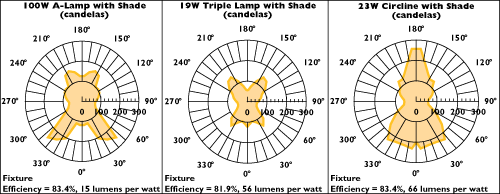

Lighting Group researcher Erik Page stands next to the new goniophotometer, shown in a multiple-exposure photo that represents a complete sensor sweep around a table lamp. The lamp is seen reflected in a mirror mounted on a swing arm, aimed at a photocell used for data acquisition.
The residential lighting sector represents a significant opportunity for energy conservation because it currently uses inefficient incandescent sources almost exclusively. Compact fluorescent lamps (CFLs) have the potential to transform this market by using one-fourth as much power as an incandescent to provide the same amount of light. While technical advances such as triphosphors and electronic ballasts have addressed issues of color rendition, flicker, and hum, CFLs still face significant market barriers, particularly because of their perceived brightness level in traditional fixture applications. When operated in fixtures originally designed for incandescents, a CFL with total light output equal to an incandescent can appear dimmer because of differences in its light distribution. One type of fixture, the common table lamp, is typically operated for more than 3 hours a day, and thus represents a significant opportunity for energy savings.
Researchers in LBNL's Lighting Systems Research Group have been conducting a series of distribution studies on a wide cross-section of CFL fixtures using a newly built apparatus known as a "goniophotometer" (see photograph, above), which can map the amount of light emitted from all angles around a light fixture. The custom-built goniophotometer rotates a large mirror around all angles of a test fixture, allowing light to be reflected from the fixture to a centrally located light meter. The apparatus is fully automated and computer-controlled, enabling researchers to generate highly accurate goniometric light intensity maps of a fixture in less than half an hour. We have collected goniometric data on different light sources (including incandescent bulbs and CFLs of various shapes) operated in standard table-lamp fixtures.
Goniometric results show that CFL orientation plays a significant role in a fixture's perceived brightness. This is illustrated by the chart at right, which shows the candlepower plots of a 100W incandescent, a vertically-oriented 19W triple-tube CFL and a 23W horizontal Circline fluorescent lamp. The plots represent one measurement sweep around the lamp and map out the candlepower distribution in a single vertical plane. Nadir is shown as 0š on the plot and corresponds to readings directly under the lamp, while zenith occurs at 180š and represents readings directly above the fixture. The incandescent lamp in the graph transmits more than 77% of its light straight into the lamp shade (typically in the range from 50š to 140š above nadir). While some of this light is transmitted through or reflected by the shade, much of the light is absorbed, adding to fixture losses. The horizontal Circline lamp sends only 64% of its light into the shade and demonstrates the advantages of focusing output vertically. Horizontally oriented lamps distribute the majority of their flux vertically because of a predominance of horizontal illuminating surfaces. While the incandescent lamp has the larger total bare-lamp light output, the Circline has a much more intense output at the crucial nadir and zenith angles. In effect, fewer total lumens are required to produce sufficient illuminance where it is most needed: at nadir for task lighting and zenith for indirect lighting.


Candlepower plots of incandescent, ordinary CFL, and Circline table lamps
Optimizing fixture geometry and lamp position can significantly increase the efficiency of these CFL fixtures. Ongoing research with the fixture industry seeks to identify and develop efficient source/fixture configurations.
--Erik Page, Michael Siminovitch and Carl Gould
![]()
Erik Page
Lighting Systems Research Group
Building Technologies Program
(510) 486-6435; (510) 486-6940 fax